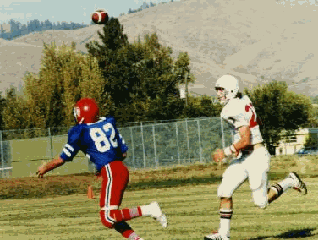|
STRATEGY AND TACTICS.
Strategy is a long term plan of action, based on current information about your opposition, your team's capabilities, probability, and your intent. strategic plans are based in the future.
Tactics are the direction of action, dictated by current situational needs. Tactics are based in the present, they are reactive measures used to keep you one step ahead of your opposition.
GAME PLAN. Your game plan is a strategic plan. it should be developed with consideration of your individual player capabilities, and your team's dynamic potential. Never try to develop strategy before you know the capabilities of your players. If your game plan does not fit your team you will have a difficult season ahead of you.
Too many coaches choose a game plan, then use their players like pieces in a jigsaw puzzle. This method usually results in much wasted time moving players around, often without acceptable results. it is better to take your time And develop a game plan that fits the team. Make your plays work for the team not against them.
Never rely on a shallow game plan, incorporate enough diversity to allow an adequate flexible response capability. In other words a contingency plan.
The contingency plan is a tactical flexibility measure, which can help keep your team competitive in difficult games. Don't leave your team to suffer defeat simply because you did not devise a contingency plan.
KEY POINTS IN GAME PLANING.
ANALYSIS. During your first few practice periods, make A player assessment. Note the strong and the weak points, of each player, Include, their enthusiasm, physical potential, mental keenness, and experience.
ASSIGNMENT. Using your, player assessment, make initial player assignments.
TENTATIVE PLANNING. Design a basic game plan around the strengths and weaknesses of your players.
TESTING. Use scrimmage to determine what flaws might exist in your tentative plan, and player assignment.
CORRECTION. Take whatever corrective actions as are necessary.
DETERMINATION. Decide what the best course of action is, and expand your tentative plan along those lines.
IMPLEMENTATION. Pull all the elements of your team, and game plan together. work on timing, and play execution.
COORDINATION. Use enhanced drill, scrimmage and discussion, to further game plan indoctrination.
REANALYZE. Look at your overall strategy critically. Find any weaknesses and work to correct all deficiencies.
CONTINGENCY. Make arrangements for tactical adjustment due to weather, player injuries, powerful opposition, and unusual circumstance. Flexibility is the key to contingency.
Strategic plans such at your game plan, are necessary for, providing direction towards meeting training requirements, and establishing continuity of Purpose.
Tactical planing is necessary for specific game conduct. Although I have already mentioned tactics as they apply to contingency planing you must know that there is more to tactics than Just that.. The time when a coach makes the most use of tactics is during his conduct of specific games. The coach enters the game by
|
|





